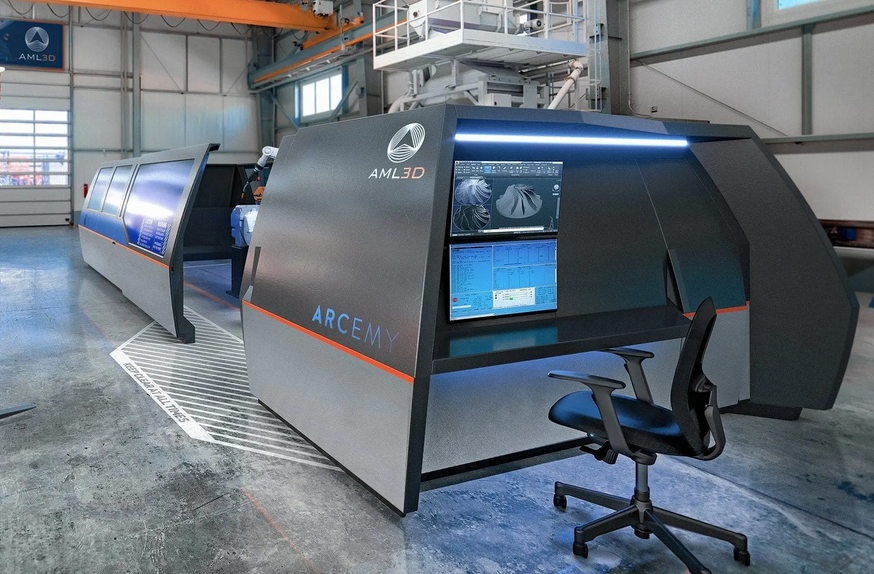We’re still waiting for maritime 3D printing to experience the same boom as other sectors, but the market is slowly starting to progress in large part with assistance from DNV’s Global Additive Manufacturing Technology Centre of Excellence in Singapore. The latest development is the certification of the “world’s largest” 3D printed shipboard fitting for Singapore-based Keppel Technology & Innovation (KTI).
The fitting is a Panama Chock, designed for towing and mooring, considered non-class applications. These elements are typically made via casting before being welded onto a supporting hull structure. In this case, Australia’s AML3D used Wire Additive Manufacturing (WAM), a form of directed energy deposition (DED), to produce the Panama Chock using a medium strength structural steel grade ER70S-6 wire feedstock.
The component was then tested by the DNV Singapore Laboratory and Marinelift Testing & Supply Pte Ltd. Singapore. This included microanalysis to gain microstructural insight into the metal part. Mechanical and non-destructive testing were also performed and matched against established cast marine grade-material. Necessary functional specifications, safety protocols, testing procedures, and acceptance criteria were all applied to the analysis of the Panama Chock, which finally achieved certification.
The resulting 1,450 kg Panama Chock demonstrated double the yield strength of the cast material, with the necessary internal strength. The part was proof load tested with a load 20 percent heavier than its designed working load.
Francois van Raemdonck, Managing Director of KTI, said, “KTI has been working on this project with Keppel O&M, DNV and AML3D since 2019, and we are proud to achieve this endorsement. Keppel is transforming the way it harnesses technology and KTI is supporting this by collaborating with Keppel business units to innovate and create value. This is in line with Keppel’s Vision 2030, which includes leveraging advanced technologies to drive growth.”
Aziz Merchant, Executive Director of Keppel Marine & Deepwater Technology, the technology arm of Keppel O&M, said, “Keppel O&M is constantly exploring new technologies to stay ahead in the industry and additive manufacturing has the potential to increase the efficiency of shipyard operations. The 3D printing of the Panama Chock shows that large components can be made available with shorter lead times and with equal standards of quality and performance. We are encouraged by the verification and we look forward to exploring how AM can be implemented on a wider scale.”
AML3D is one of the few DED firms that is tackling additive manufacturing in the maritime space, where DNV leads as the world’s largest classification society. It has produced a 3D printed crane and is working with the Australian Navy and BAE Systems Australia subsidiary ASC Shipbuilding. Additionally, AML3D is in the process of 3D printing an impeller for Thyssenkrupp and Wilhelmsen, the leaders in maritime 3D printing.
AML3D Chief Executive Officer, Andrew Sales said, “We’re proud to have been able to partner with KTI and demonstrate the advantages of our patented Wire Additive Manufacturing (WAM) capabilities in the creation of the world’s largest 3D printed Panama Chock. Additionally, we are equally as excited to see this WAM printed component receive official verification by DNV. This now offers a quality assurance pathway for a wide range of components that can follow a similar validation process. It is a fantastic achievement by DNV, KTI, the AML3D team and our other partners in this project. Working with KTI’s vision for implementing AM has been a further endorsement for our own business model and we’re excited for the future.”
With the “world’s largest” 3D printed maritime part, the Australian firm only demonstrates its capabilities further. Meanwhile, the sector is being neglected by other providers, giving AML3D a leg-up in the space before others can even get their bearings.
Subscribe to Our Email Newsletter
Stay up-to-date on all the latest news from the 3D printing industry and receive information and offers from third party vendors.
Print Services
Upload your 3D Models and get them printed quickly and efficiently.
You May Also Like
Nikon SLM Solutions Sells SLM 500 to Primary Weapon Systems to Expand Suppressor Production
Primary Weapons Systems (PWS) is a Boise, Idaho-based manufacturer of suppressors, firearms, and related components. A subsidiary of Vigilant Gear and a sister company to aftermarket Glock slide manufacturer Lone...
3DPOD 261: Tooling and Cooling for AM with Jason Murphy, NXC MFG
Jason Murphy´s NXC MFG (Next Chapter Manufacturing) is not a generalist service; instead, the company specializes in making tooling. Using LPBF and binder jet, the company produces some of the...
HP and Firestorm Labs Form Partnership to Use Multi Jet Fusion 3D Printers in Deployable Factories
HP Inc., maker of a range of additive manufacturing (AM) solutions including the Multi Jet Fusion (MJF) ecosystem, has announced a partnership with Firestorm Labs, a developer of containerized, deployable...
3D Printing News Briefs, July 2, 2025: Copper Alloys, Defense Manufacturing, & More
We’re starting off with metals in today’s 3D Printing News Briefs, as Farsoon has unveiled a large-scale AM solution for copper alloys, and Meltio used its wire-laser metal solution to...


































